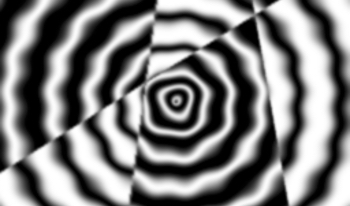
We propose a new anisotropic diffusion process for removing noise from MRI images without distorting the edges. The method is based on a simple principle: any diffusion that increases a gradient at neighbouring pixels should be prohibited. From this principle, we deduce an inequality that allows diffusion along the edges but not across them. We introduce promising results using synthetic data with various types of noise as well as real MRI scans.

The high-resolution magnetic resonance image (MRI) provides detailed anatomical information critical for clinical application diagnosis. However, high-resolution MRI typically comes at the cost of long scan time, small spatial coverage, and low signal-to-noise ratio. The benefits of the convolutional neural network (CNN) can be applied to solve the super-resolution task to recover high-resolution generic images from low-resolution inputs. Additionally, recent studies have shown the potential to use the generative advertising network (GAN) to generate high-quality super-resolution MRIs using learned image priors. Moreover, existing approaches require paired MRI images as training data, which is difficult to obtain with existing datasets when the alignment between high and low-resolution images has to be implemented manually.This paper implements two different GAN-based models to handle the super-resolution: Enhanced super-resolution GAN (ESRGAN) and CycleGAN. Different from the generic model, the architecture of CycleGAN is modified to solve the super-resolution on unpaired MRI data, and the ESRGAN is implemented as a reference to compare GAN-based methods performance. The results of GAN-based models provide generated high-resolution images with rich textures compared to the ground-truth. Moreover, results from experiments are performed on both 3T and 7T MRI images in recovering different scales of resolution.

Digital Imaging and Communications in Medicine (DICOM) is an international standard to transfer, store, retrieve, print, process and display medical imaging information. It provides a standardized method to store medical images from many types of imaging devices. Typically, CT and MRI scans, which are composed of 2D slice images in DICOM format, can be inspected and analyzed with DICOM-compatible imaging software. Additionally, the DICOM format provides important information to assemble cross-sections into 3D volumetric datasets. Not many DICOM viewers are available for mobile platforms (smartphones and tablets), and most of them are 2D-based with limited functionality and user interaction. This paper reports on our efforts to design and implement a volumetric 3D DICOM viewer for mobile devices with real-time rendering, interaction, a full transfer function editor and server access capabilities. 3D DICOM image sets, either loaded from the device or downloaded from a remote server, can be rendered at up to 60 fps on Android devices. By connecting to our server, users can a) get pre-computed image quality metrics and organ segmentation results, and b) share their experience and synchronize views with other users on different platforms.

Compressed sensing (CS) has been exploited for accelerating data acquisition in magnetic resonance imaging (MRI). MR images can be then reconstructed from significantly fewer measurements, i.e., drastically lower than that required by the Nyquist sampling criterion. However, the compressed sensing method usually produces images with artifacts, particularly at high reduction rates. In this paper, we propose a novel compressed sensing MRI method, called CS-NLTV that exploits curvelet sparsity (CS) and nonlocal total variation (NLTV) regularization. The curvelet transform is optimal sparsifying transform with the excellent directional sensitivity than that of wavelet transform. The NLTV, on the other hand extends the total variation regularizer to a nonlocal variant which can preserve both textures and structures and produce sharper images. We have explored a new approach of combining alternating direction method of multiplier (ADMM), adaptive weighting, and splitting variables technique to solve the formulated optimization problem. The proposed CSNLTV method is evaluated experimentally and compared to the previously reported high performance methods. Results demonstrate a significant improvement of compressed MR image reconstruction on four medical MRI datasets.